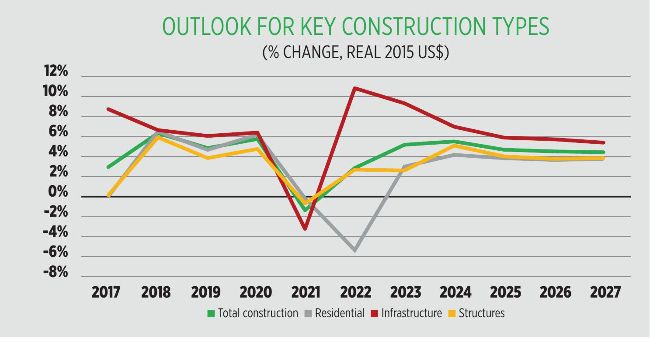INFRASTRUCTURE LEASA THE CHARGE
When the construction economy slows, China typically boosts spending on infrastructure – with over 10,000 infrastructure projects launched throughout the economy China has tuned to this tactic again, reports
Scott Hazelton
Mainland China’s economic growth accelerated significantly in the first quarter (Q1) as economic activities began to normalise after the ending of its zero-Covid policy. Real Gross Domestic Product (GDP) rose 4.5% year over year (YoY) in Q1 2023, up from 2.9% in Q4 2022.
The segments of the economy that were hit hardest by pandemic controls rebounded strongly. The hospitality and transportation sectors recovered sharply, from contracting 5.8% YoY and 3.9% YoY, respectively, in Q4 2022 to growing 13.6% and 4.8% in Q1 2023.
The real estate sector returned to growth in Q1 2023, rising 1.3% YoY from a 7.2% decline in Q4 2022. Before this expansion, the real estate sector had contracted for six consecutive quarters. Supported by infrastructure investment, the construction sector maintained a relatively high growth rate of 6.7% YoY in Q1 2023, compared with 7.0% in Q4 2022.
Positive outlook for construction
Despite easing monetary policy that led to accelerating corporate borrowing in recent months, private businesses’ investment demand remains weak. Year-to-date fixed asset investment by private enterprises decelerated from growing 4.1% YoY in May 2022 to just 0.6% YoY in March 2023. Most new lending went to state-owned enterprises, whose fixed asset investment grew 10.0% YoY in Q1 2023.
The outlook for Chinese construction is generally positive; real total construction spending grew 2.9% in 2022. Total construction spending is expected to continue, increasing 5.2% in 2023 and 5.6% in 2024. While residential construction declined 5.4% in 2022, the sector is expected to increase 3.0% in 2023 and 4.2% in 2024.
We anticipate nonresidential structures spending will expand 2.6% in 2023 and another 5.2% in 2024, driven by commercial construction in 2023 and institutional construction in 2024. Infrastructure construction spending is on track to increase by 9.4% in 2023 and 7.0% in 2024.
Mainland China’s housing market continues to improve. According to the National Bureau of Statistics (NBS), based on a housing price survey in 70 large- and medium-size cities, new home prices increased in 64 of 70 cities in March compared with 55 cities in January. Yet, housing market woes are not fully over. Recent improvements in housing market prices and sales have not led to a recovery of construction starts, which contracted 17.8%
YoY in Q1 2023 compared with an 8.7% decline in January-February. While growth does return in 2023, it will be late 2024 before residential spending recovers to 2021 levels.
Nonresidential structures are also struggling for growth. The problem stems primarily from the office segment, although all structure types are well off their pace. China’s late removal of Covid prevention measures delayed the disruption and recovery to the office construction market compared with North American and European economies.

Source: IHS Marklit
Impact of urbanisation
The country’s increasing urbanisation mitigates the work-from-home transition somewhat, and office demand should stabilise in 2023 but improvements will remain modest. Growth will be strongest for office space associated with the strongest recovering economic sectors – finance, technology and manufacturing.
Commercial construction fares a little better, but the outlook is still tepid. With the ending of Covid-related constraints, consumer spending on goods and services, has improved. Lodging is a primary beneficiary.
With exports recovering, the demand shifts from domestic supply chain to global markets. The normally reliable institutional segment also sees modest growth. While spending on health care construction rose over 20% in 2022, both education and health care are growing at roughly 3.5% in 2024 and 7% in 2025.
China’s industrial construction sector had a strong 2022, but faces challenges. Domestic demand will continue to improve, but most consumer spending growth is coming from services, not goods. Additionally, China continues to lose share to other developing Asian markets with lower labour costs, and some firms are diversifying their geographic footprint to reduce their reliance on China.
When the construction economy slows, China typically boosts spending on infrastructure, and they have adopted that strategy again; several new stimulus programs, totalling over RMB1.1 trillion, were announced late last summer, and by now more than 10,000 infrastructure projects have been launched throughout the economy, covering areas such as energy, transport infrastructure and industrial parks.
While the provincial infrastructure plans will provide a significant boost to the economy, concerns persist regarding financial stability due to rising local government debt, which is expected to reach a new high. This spending is also front-loaded to bridge the recovery from the pandemic slowdown. Accordingly, the strongest growth occurs in the near term.
Historically, China has invested disproportionate amounts in transportation infrastructure, particularly highways and highspeed rail. While this appears to be the case in 2025 and beyond, 2022 and 2023 feature healthy doses of spending on energy, water conservancy and wastewater treatment. The focus appears to be on energy conservation rather than generation or transmission/ distribution, so energy infrastructure growth tails off quickly. The manufacturing of energy equipment remains strong as the rest of the world continues to demand solar facilities, where China is the global leader.

Established in 1959, IHS is the leading source of information, insight and analytics in critical areas that shape today’s business landscape. Businesses and governments in more than 150 countries around the globe rely on the comprehensive content, expert independent analysis and flexible delivery methods of IHS to make high-impact decisions and develop strategies with speed and confidence. Headquartered in Colorado, US, IHS employs about 8,800 people in 32 countries.